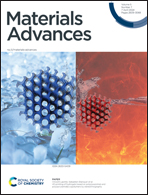A high heat dissipation strategy based on a multi-scale porous hydrogel and heat sink exhibiting cooling capacity comparable to that of forced air convection but with zero energy consumption†
Abstract
Heat dissipation is critical for energy efficiency; high operating temperatures can even cause electronic device failure. Herein, a high heat dissipation strategy is proposed and applied to a passive composite heat sink (CHS) by combining a porous hydrogel with fin. The heat generated by the devices can be dissipated utilizing the evaporation latent heat of the water in the multi-scale porous hydrogel and the increased heat dissipation area of the composite finned structure. The heat transfer coefficient of the CHS can reach 60 W m−2 K−1, which is six times higher than that of natural convection and comparable to that of forced air convection. Moreover, rehydration can be achieved with zero energy consumption. The CHS is able to enhance the temperature difference of the thermoelectric generator (TEG) and improve the output performance by 4–10 times. In addition, it can lower the operating temperature of electronic devices and solar cells, which can be maintained at about 60 °C when the heat load is 10 W. As a result of excellent cooling performance and zero energy consumption properties, the CHS has potential applications in the fields of thermoelectric devices, electronic products, and solar photovoltaic power generation.



 Please wait while we load your content...
Please wait while we load your content...